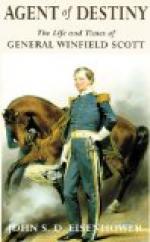There remained yet to be captured the convent of San Pablo. This building, having very thick walls, was impervious to the attack of field pieces. It was defended by a well-constructed bastion, with flooded ditches, and guns placed in the embrasure. The attack was made by the First Artillery, followed by the Third Infantry. During the attack the enemy made several sallies from the convent, which were repulsed. The troops in the convent consisted of the Independencia and Bravo battalions, about six hundred and fifty each, with the necessary cannoneers for six guns, and in the tete-de-pont cannoneers for five guns, the San Patricio companies, and the battalion of Tlapa. Along the Rio Churubusco, on the north side, was the brigade of General Perez, some twenty-five hundred strong. The Mexicans made a brave and gallant defense, but were compelled to succumb. The battles of Contreras and Churubusco were fought on the same day, and were really one battle. In both actions the American loss was one hundred and thirty-nine killed and nine hundred and twenty-six wounded. The Mexican loss was near four thousand killed and wounded, with the loss of three hundred prisoners, thirty-seven cannon, and a large number of small arms with ammunition.
General Scott could easily have occupied the Mexican capital on the same day, but meanwhile Mr. Nicholas P. Trist had arrived from Washington with instructions from the President to endeavor to make a treaty of peace, and both he and General Scott thought it best to await the turn of events looking to that end. On the next morning, August 27, 1847, General Scott set out on the San Antonio road, and was met near Churubusco by a deputation bearing a white flag from the Mexican Government, proposing an armistice of thirty hours for burying the dead and collecting the wounded, which he at once rejected. The deputation accompanying the flag consisted of Senores Basadre, Mora y Villamil and Aranjos, who had been sent by Pacheco, Minister of Foreign Affairs. General Santa Anna expressed great dissatisfaction at the action of the Minister, on which he resigned. General Scott addressed a communication to the head of the Mexican Government and general in chief, in which he said that too much blood had already been spilled, and suggested that it was time the differences between the two republics should be settled. He mentioned (what was known to the Mexican authorities) that a commissioner on the part of the United States, clothed with full power to that end, was with his army. He expressed his willingness on reasonable terms to agree to a short armistice. While he proposed to wait until the next morning for a reply, he announced his intention “in the meantime to seize and occupy such positions outside of the capital as I may deem necessary to the shelter and comfort of this army.”
The Mexican authorities, through Alcorta, Secretary of War and of the Navy, named two brigadier generals of the Mexican army, Mora y Villamil and Benito Quijano, to act as commissioners.




